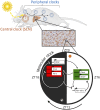Regulation of Mammalian Physiology by Interconnected Circadian and Feeding Rhythms
- PMID: 28337174
- PMCID: PMC5340782
- DOI: 10.3389/fendo.2017.00042
Regulation of Mammalian Physiology by Interconnected Circadian and Feeding Rhythms
Abstract
Circadian clocks are endogenous timekeeping systems that adapt in an anticipatory fashion the physiology and behavior of most living organisms. In mammals, the master pacemaker resides in the suprachiasmatic nucleus and entrains peripheral clocks using a wide range of signals that differentially schedule physiology and gene expression in a tissue-specific manner. The peripheral clocks, such as those found in the liver, are particularly sensitive to rhythmic external cues like feeding behavior, which modulate the phase and amplitude of rhythmic gene expression. Consequently, the liver clock temporally tunes the expression of many genes involved in metabolism and physiology. However, the circadian modulation of cellular functions also relies on multiple layers of posttranscriptional and posttranslational regulation. Strikingly, these additional regulatory events may happen independently of any transcriptional oscillations, showing that complex regulatory networks ultimately drive circadian output functions. These rhythmic events also integrate feeding-related cues and adapt various metabolic processes to food availability schedules. The importance of such temporal regulation of metabolism is illustrated by metabolic dysfunctions and diseases resulting from circadian clock disruption or inappropriate feeding patterns. Therefore, the study of circadian clocks and rhythmic feeding behavior should be of interest to further advance our understanding of the prevention and therapy of metabolic diseases.
Keywords: circadian rhythm; feeding behavior; genomics; liver; metabolism; proteomics.
Figures
References
Publication types
Grants and funding
LinkOut - more resources
Full Text Sources
Other Literature Sources



